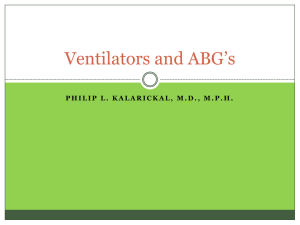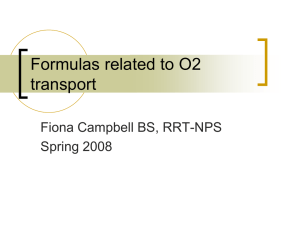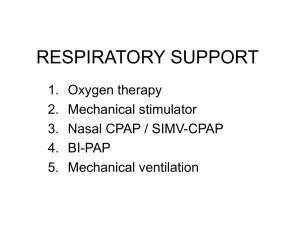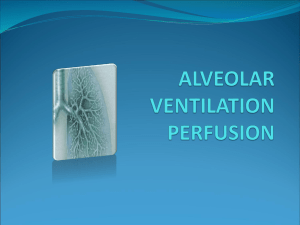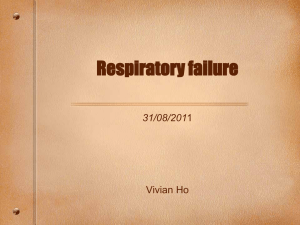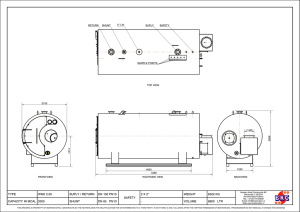Causes of Hypoxemia - Macomb
advertisement
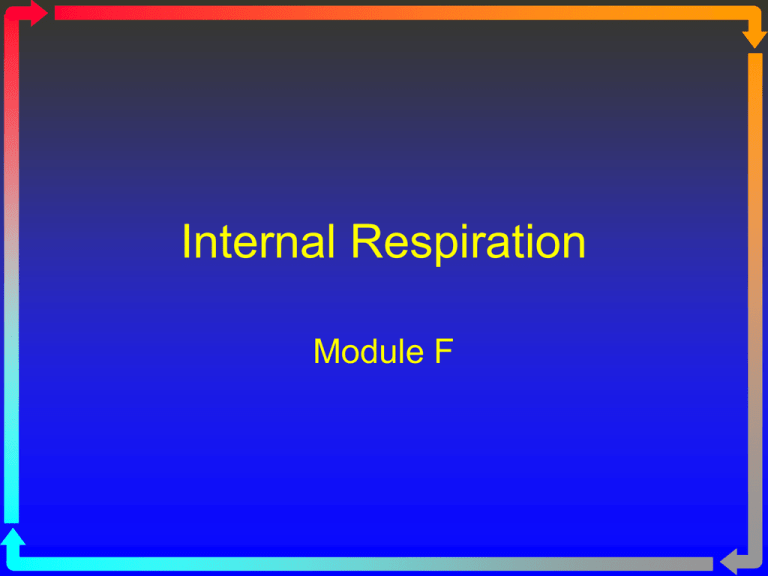
Internal Respiration Module F Module F • Chapter 9 – Assessment of Hypoxemia and Shunting • Chapter 10 – Treatment of Hypoxemia and Shunting • Chapter 11 – Hypoxia: Assessment and Intervention Objectives At the conclusion of this session the participant will: • Still be awake! This covers 3 chapters! • Relax…most is a review and some will be covered in Winter 09. • Define oxygen extraction. • Describe the effects of anaerobic metabolism. • State the formula for calculating RQ. • List the 5 causes of hypoxemia. • State the effect of an increase or decrease in cardiac output on the shunt fraction. • List three methods, other than the shunt fraction, which can be used to assess the degree of physiologic shunting. • State three ways to treat acute hypoxemia. Objectives • Define anemia. • List three types of anemia and state the causes of the defect. • Describe the effect of anemia on the presence of hypoxia. • State the benefit, problems, and specific levels for each of the following as it relates to it being an indicator of cellular hypoxia: • Lactate • Mixed Venous Oxygenation • Oxygen Consumption & Utilization • Gastric Mucosal Acidosis Internal Respiration • Exchange of oxygen and carbon dioxide at the cellular level. • Some control by local vasculature. • Increased distance from capillary to tissue will result in decreased delivery. • Some organs use more than others. • Table 7-1 (p. 188). • Note: % of blood flow is not equal to volume of oxygen consumed. Internal Respiration • Normal metabolism exists when O2 is consumed and CO2 is produced. • Normal ratio of CO2 produced : O2 consumed is 0.8:1 (200/250) • Increased ratio with excess CHO utilization; decreased with fat & ETOH. • When insufficient oxygen is present, anaerobic metabolism results. • Less ATP produced. • Lactic Acid is produced. Adequacy and Efficiency of Oxygen Delivery • Adequacy: Is there sufficient oxygen present? (Hint: Is hypoxemia present?) • Causes of Hypoxemia • Low PIO2 • • • • • Hypoventilation Absolute Shunts Relative Shunts Diffusion Defects True or Absolute Deadspace (secondary mechanism) • Efficiency: Is the PaO2 appropriate for the FIO2? • If not…assume a shunt is present! Effects of Cardiac Output on PaO2 • The normal decrease in PaO2 from alveolar oxygen levels is due to the small mixing of anatomically shunted blood (5%). • This blood is venous in nature and has a PO2 the same as the P O2. • Four situations exist that can affect the PaO2: • Decreased Cardiac Output with a Normal Shunt • Increased Shunting with a Normal Cardiac Output • Decreased Cardiac Output with an Increased Shunt • Increased Cardiac Output with an Increased Shunt The Normal Ventilation/Perfusion Relationship • Normal PAO2 • Normal PćO2 • Normal P O2 • Normal CO • Normal Oxygen Consumption • Normal PaO2 Decreased Cardiac Output with a Normal Shunt • P O2 decreases with a decrease in cardiac output because of an increased oxygen extraction (assuming O2 doesn’t change). • Any shunted blood will have a reduced P O2 . • Because the amount of shunted blood is so small, the decrease in PaO2 isn’t significant. Increased Shunting with a Normal Cardiac Output • Example: ARDS • Normal Cardiac Output = Normal P O2 • The problem here is a significant increase in intrapulmonary shunt, meaning more P O2 “contaminated” blood entering the pulmonary vein (arterial system). Decreased Cardiac Output with an Increased Shunt • Similar to the first scenario, but here there is an increased intrapulmonary shunt. • Example: ARDS with an MI • Reduced Cardiac Output yields a reduced P O2 (higher extraction). • More of that low P O2 blood is shunted in the lungs, resulting in a large reduction in PaO2. Increased Cardiac Output with an Increased Shunt • Normal physiologic response to hypoxemia is to increase heart rate (peripheral chemoreceptors) and Cardiac Output. • P O2 is increased (better oxygen delivery). • With an increased intrapulmonary shunt, however, there still is an increased amount of P O2 “contaminated” blood entering the system. So What? • Don’t always assume that an improvement or deterioration in PaO2 is occurring solely because of a change in pulmonary gas exchange. • Suspect a change in cardiac output when an abrupt, unexplained hypoxemia is observed in critically ill patients. • Also, consider other non-cardiac causes of reduced P O2. • Anemia • Increased metabolism (fever) • Maldistribution of systemic perfusion Assessment of Hypoxemia • Definition of “Hypoxemia”. • Severity? • Causes of Hypoxemia • Differential Diagnosis of Hypoxemia Abnormality PaO2 PaCO2 Hypoventilation Absolute Shunt N or Relative Shunt N, , Diffusion Defect N at Rest, w/ exercise N or RA P(A-a)O2 100% O2 P(A-a)O2 N N N N at rest, with exercise N Shunt Substitutes • P(A-a)O2 • PaO2/PAO2 • PaO2/FIO2 PAO2 • PAO2 = [(PBARO - PH2O) x FIO2] – (PaCO2/0.8) • On FIO2 of less than 60% • PAO2 = [(PBARO - PH2O) x FIO2] – PaCO2 • On FIO2 greater than 60% • Normal Values: • Room Air: 100 – 104 mm Hg • 100% Oxygen: 600 P(A-a)O2 • Normal values is around 10 mm Hg on room air. • Values increase with increasing age and the supine position. • Normal values 25-65 mm Hg on 100% • Difficult to use when FIO2 varies from 21 or 100% • Normal values differ for each FIO2 • Limited value when using supplemental oxygen. P(A-a)O2 on Room Air • Normal A-a gradient on 21% is seen with: • Pure hypoventilation • High altitude • Diffusion defect (patient at rest) • Abnormal A-a gradient on 21% is seen with • Relative shunt • Absolute shunt P(A-a)O2 on 100% • Relative Shunt will improve • A-a gradient less than 300 mm Hg • Absolute Shunt will not improve • A-a gradient is greater than 300 mm Hg Using P(A-a)O2 to Estimate Shunt • On 100% FIO2, a 1% shunt is estimated for every 10 – 15 mm Hg P(A-a)O2 • Example: A-a gradient is 140 mm Hg • 140 = 9.3% 15 140 = 14.0% 10 Using P(A-a)O2 to Estimate Shunt • Normal Shunt is 5% • Add 5 % to the normal 5% shunt for every 100 mm Hg gradient; Example: • 100 mm Hg – 10% • 200 mm Hg – 15% • 300 mm Hg – 20% Shunt Equation • Classic Shunt Equation • “Gold Standard” • Clinical Shunt Equation • A shunt greater than or = 15% is significant • Increased shunts will correlate with • “White out on x-ray unless its cardiac in origin. • Atelectasis, pneumonia, pulmonary edema, ARDS Classic Shunt Equation Q s CcO2 CaO2 100 Q t CcO2 Cv O2 • Where: • CćO2= (1.34 x Hb x 1.0) + (PAO2 x .003) • Assumes 100% saturation in the ideal alveolus • Requires a Pulmonary Arterial Catheter (BTFDC) Clinical Shunt Equation Q s P A a O2 .003 Q t P A a O2 .003 CaO2 Cv O2 • Requires a Pulmonary Arterial Catheter (BTFDC) • Only accurate at lower FIO2 PaO2 /PAO2 (a-A ratio) • Normal value is greater than 75% on any FIO2 • Example: 100/104 = 96% • 96% of oxygen is diffusing across the A-C membrane PaO2/FIO2 ratio • • • • Normal value is 400 – 500 Example: 100 mm Hg/.21 = 476 Value between 200 – 300 = ALI Value less than 200 = ARDS • Values less than 200 correlate with a shunt of greater than 20% Treatment of Hypoxemia • Increase FIO2 • Increase MAP • PEEP, Inspiratory Time, Vt • Body Positioning • Prone Positioning • Lateral decubitus (good lung down) • Good bronchial hygiene • Suction, bronchodilators, CPT/Flutter/PEP Oxygen Administration • Treat hypoxemia/Hypoxia • Decrease the work of breathing • Decrease the work of the heart Hazards of Oxygen Therapy • • • • Absorption atelectasis Oxygen Toxicity Retinopathy of prematurity Oxygen induced hypoventilation in COPD • Look for oxygen levels above 60 mm Hg and a rising PaCO2 • Evaluate FIO2 patient is receiving • Patient symptomatic: sleepy, lethargic Hyperoxemia • PaO2 greater than 100 mm Hg • Usually undesirable • Very little oxygen content is gained • A PaO2 above 130 mm Hg indicates the patient is breathing supplemental oxygen. • Hyperoxemia is indicated in COHb%. Hyperoxemia • SpO2% of 100% means the PaO2 could be between 100 mm Hg & 600 mm Hg • Very dangerous in infants Oxygen Administration in Chronic Hypercapnia • PaO2 will increase 3 mm Hg for each 1% increase in FIO2 • Keep PaO2 around 60 mm Hg • FIO2 = 60 - PaO2 on room air 3 Example • You are asked to draw an ABG on a CO2 retainer. The PaO2 is 39 mmHg on 21% Where should the FIO2 be set? FiO2 = 60 - 39 = 7% Add to 21% 3 • Set FIO2 at 28% Calculating the maximal PaO2 for any given FIO2 • The PaO2 on room air during hyperventilation may go up to 130 mm Hg • A PaO2 more than 5 times the % of oxygen is suspicious. • • • • 30 40 50 60 x x x x 5 5 5 5 = = = = 150 200 250 300 Problem • pH 7.32, PaCO2 48, PaO2 200, FIO2 .30 • PAO2 = 760 – 47 x 0.30 – 48/.8 = 154 mm Hg • Can’t have a PaO2 greater than PAO2, so… • Either the FIO2 was not recorded accurately • Lab error (air bubble) Evaluating FIO2 • High flow devices may not be delivering the FIO2 that is set • If the patient’s total flowrate is exceeding the flow from the oxygen delivery device, the FIO2 will decrease • Water in the aerosol tubing will increase FIO2 • High flow oxygen delivery systems should be analyzed Analyze High Flow Systems • Polarographic (battery and electrolyte solution) • Galvanic (fuel cell) • Troubleshooting: If analyzer is not reading the FIO2 within + 2% then: • Calibrate analyzer first • Change fuel cell (galvanic) or • Change battery/electrolyte level (polarographic) Correlating ABG to the Patients Condition • A patient who looks good but has bad ABG • Suspect a lab error • Venous blood gas sample • COPD (high PaCO2 and HCO3-) Correlating ABG to the Patients Condition • A patient who looks and feels bad but ABG are good. • CO poisoning, MetHB% • Tissue hypoxia • Anemic hypoxia • Histotoxic hypoxia • Circulatory hypoxia • Pulmonary embolism – high Vd/Vt ratio and high E Analyzing an ABG • On 21%, add PaCO2 and PaO2 to see if greater than 150. • If one of the three acid base parameters is abnormal, there is an error. • pH 7.58, PaCO2 40, HCO3- 24 • PaO2 cannot be greater than PAO2 on any FIO2. Analyzing an ABG • Know normal venous values and suspect when a venous sample may have been drawn • Inaccurate FIO2 • Improperly recorded • Patients total flow exceeds flow from delivery device • FIO2 recorded from low flow system • Water in the aerosol tubing Objectives • Define anemia. • List three types of anemia and state the causes of the defect. • Describe the effect of anemia on the presence of hypoxia. • State the benefit, problems, and specific levels for each of the following as it relates to it being an indicator of cellular hypoxia: • • • • Lactate Mixed Venous Oxygenation Oxygen Consumption & Utilization Gastric Mucosal Acidosis Hypoxia • Definition: Reduced oxygen levels at the tissue. • No “best” index for assessing tissue oxygenation. • Begin assessment by assessing the components of oxygen delivery: • • • • Dissolved Oxygen Bound Oxygen Hemoglobin Cardiac Output (This will be covered in RSPT 2420) • Then look at markers of the effects of possible tissue hypoxia. Types of Hypoxia • • • • Hypoxemic Hypoxia Circulatory (Stagnant) Hypoxia Anemic Hypoxia Histotoxic Hypoxia Oxygenation Indices • Dissolved Oxygen as an index of hypoxia. • Not very useful • Pretty good bet hypoxia is present with severe hypoxemia • Be careful at extremes! • Keep PaO2 above 60 mm Hg. • Combined Oxygen (SaO2) as an index of hypoxia. • Make sure how you know HOW it is reported • SaO2 with nomogram, 2-wavelength oximetry, CO-Oximetry, Pulse Oximetry • Better than PaO2, but has its faults. • Abnormal species of hemoglobin • Insensitive in telling deterioration or at high PaO2 levels. Anemia • RBC: • 5 million/mm3 in men; 4.5 million/mm3 in women. • Hemoglobin • 15 g% in men, 13 to14 g% in women. • Anemia defined as a reduction in the amount of circulating RBC or hemoglobin. • Hematocrit (formed elements in blood) • 47% in men, 42% in women. • Too low is bad; too high is bad. Types of Anemia • Presence of anemia means one of two things: • Decrease in production of RBC or Hb • Bone Marrow Failure (Aplastic Anemia) • Usually due to chemical or physical agent (normocytic) • Inadequate Hemoglobin synthesis • Iron deficiency 2° chronic blood loss or pregnancy (microcytic) • Pagophagia: Ice chip craving • Thalassemias – genetic disorder (microcytic) • Inadequate RBC formation • Folic Acid deficiency: Green vegetables & alcoholics (macrocytic) • B12 deficiency: Pernicious anemia 2° lack of intrinsic factor (macrocytic) • RBC & Hb are being lost or destroyed at an accelerated rate. • Blood loss • Acute bleeding (normocytic) • Excessive hemolysis • Sickle cell disease Analyzing FIO2 • Always correlate ABG to patients condition. • When drawing from an A-line, always remove all heparin from the lines – this means withdrawing 3-5 cc and discarding. • Understand the relationship of increased metabolism with leukocytosis (leukemia). Anemia and Hypoxia • Mild anemia (10 g%) usually won’t cause hypoxia • 25% extraction • Cardiac output reserves (acute) • Changes in levels of 2,3 DPG (cardiac) • Probably significant with Hb < 6 g% • Transfuse when Hb levels fall below 7 g% Key Indicators of Hypoxia • • • • • Lactate Mixed Venous Oxygen Oxygen Consumption/Oxygen Extraction Gastric Tonometry Vital Organ Function Lactate • Immediate response to a reduced oxygen delivery is the onset of anaerobic metabolism. • • • • Glycolysis: Pyruvate reduction to lactate. Normal lactate is 0.9 to 1.9 mM/L or 8 to 17 mg/dL Metabolic Acidosis + hypoxemia + CO = Hypoxia Increase in mortality at levels above 2.5 mM/L; 90% at levels above 8 mM/L • Problem is lactate elevation is not linear (not a good early predictor) • Reduction is by liver. Poor perfusion/Liver failure worsens prognosis. • Cyanide poisoning (Histotoxic hypoxia) should be suspected with high lactates and no increase in HbCO with smoke inhalation. Mixed Venous Oxygenation • Requires a pulmonary artery catheter. • Assessment of oxygen supply vs. demand • S O2: Continuous vs. Spot Check • Normal 75% • Decreased with increased O2, decreased SaO2, decreased Hb or decreased CO. • P O2: Average end-capillary driving pressure. • Usefulness depends on distribution of cardiac output. • Decreases are associated with decreased supply or increased demands. • Increases are associated with reduced utilization (NOT ALWAYS A GOOD THING!) Oxygen Uptake and Utilization • Normal oxygen uptake (consumption) by the tissue remains constant despite changes in cardiac output because of huge reserve (25% normal extraction). • Hypoxia is present when O2del falls below 8 to 10 ml/kg/min. • Covert Hypoxia: Normally, increasing oxygen delivery is not needed; in some situations (MOF secondary to ARDS, septic shock, ARF). The cause is suspected to be an altered oxygen utilization. Gastric Tonometry • Blood shunting to key organs occurs with reduced oxygen supply at the expense of non-vital organ systems (GI tract). • If hypoxic crisis is present, GI involvement will be a primary source. • The mixing of gases to a point of equilibration is called tonometry. • Use of a specialized catheter with a balloon can measure the gastric carbon dioxide and infer gastric blood flow. Sublingual Tissue PCO2 • Improvement on gastric tonometry. • Uses CO2 sensor in “temperature” like probe. • Results within 60 seconds. Vital Organ Function • If compensatory mechanisms are intact, the presence of these compensatory mechanisms may be an indication that hypoxia is present. • • • • Urine output Mental status Skin coolness Great toe temperature
